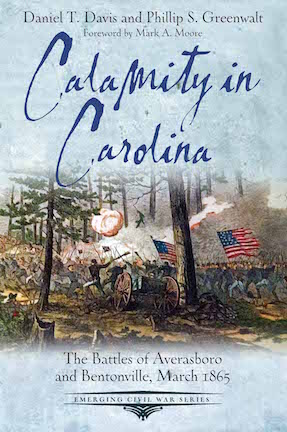The Unexpected Monument
Much to my surprise, I recently ran into the battle of Bentonville—south of Fayetteville.

I was heading north on I-95 through North Carolina when I pulled into a rest stop. There, on the edge of a parking lot, I saw a monument to the battle: a metal plaque mounted on a brick face.
The monument dates to 1962 and was erected by the state highway department. So, it’s not like a huge surprise that a monument suddenly appeared along the interstate—it’s just that it’s new to me because I’d never stopped at that particular rest stop before. I wasn’t really expecting a Civil War monument.
I shouldn’t have been surprised by a seemingly surprising roadside monument, though. Earlier in the afternoon, in South Carolina, I had stopped at a rest area that had a small circular fountain off to the side of the restrooms. On the concrete bench surrounding the fountain were inscribed words from JFK’s inaugural address: “we shall pay any price, bear any burden, meet any hardship…” and so on. I was delighted to find such wonderful words in such an unexpected spot.
 The Bentonville monument features a sketch that originally appeared in Frank Leslie’s Illustrated Newspaper. That same sketch appears on the Emerging Civil War Series book Calamity in Carolina: The Battles of Averasboro and Bentonville by Dan Davis and Phill Greenwalt. In fact, that’s what first caught my eye. “Hey, it’s the cover of Dan and Phill’s book!” I thought.
The Bentonville monument features a sketch that originally appeared in Frank Leslie’s Illustrated Newspaper. That same sketch appears on the Emerging Civil War Series book Calamity in Carolina: The Battles of Averasboro and Bentonville by Dan Davis and Phill Greenwalt. In fact, that’s what first caught my eye. “Hey, it’s the cover of Dan and Phill’s book!” I thought.
You can find more on the history of the monument and an inscription of the text at the Historical Markers Database.
The unexpected nature of my find—again, unexpected to me—brought to mind a rest area along I-95 south of Fredericksburg, just before the exit to Caramel Church and the North Anna Battlefield. There, displays explore “Petersburg: The Last Days of the Confederacy.” Petersburg is nearly an hour further to the south, with Richmond in between, so I always thought it an odd place to have Petersburg stuff. However, with the I-295 bypass around Richmond that terminates near Petersburg, I guess it makes sense to try and attract the attention of as many wayfarers as possible before the highway splits.
That got me to wondering: Where along your travels have YOU run across unexpected Civil War monuments?
Growing up in California, roadside markers (aka Roadside Distractions, Hysterical Markers, etc.) were usually related to pioneering settlers, but my dad stopped at them all! I guess my favorites concerned the Donner Party. It was pretty much an unwritten rule that someone would start the countdown: Donner, Party of Seven; Donner, Party of Six. and so on. And going over those passes, one’s first glimpse of Lake Tahoe is breathtakingly memorable.
That’s probably a terrible thing to laugh at, but I did anyway! 😀
But seriously; on a more serious note. On the east side of Waynetown,IN, in a small cemetery, is a plague denoting the burial site of a member of the Lewis and Clark expedition. Waynetown is on route 136 west of Crawfordsville,IN, where General Lew Wallace lived and attended Wabash College back in the day. Wabash is a great men’s college and happens to be the alma mater of our favorite son in ’92.
Outside of New Orleans, there is an historical marker for Camp Parapet along the River Road in Jefferson Parish. The marker denotes it as the location of a Confederate camp but fails to mention its later function (after the fall of New Orleans in 1862) as one the first training grounds for USCT.
Camp Wright in Warner Springs, CA. My brothers and I were heading through the mountain pass for a day of hiking in the desert and I insisted that they stopped at the historical marker. Behold- it was for a Civil War era camp established in 1861 to discourage Confederate supporters from leaving CA.
Finns Point National Cemetery, near Pennsvile, NJ, and across the river from Ft. Delaware. 2,436 Confederates who died at Ft. Delaware are buried in a mass grave marked by an 85 foot tall granite obelisk. Unexpected to find all these Confederates buried in South Jersey.